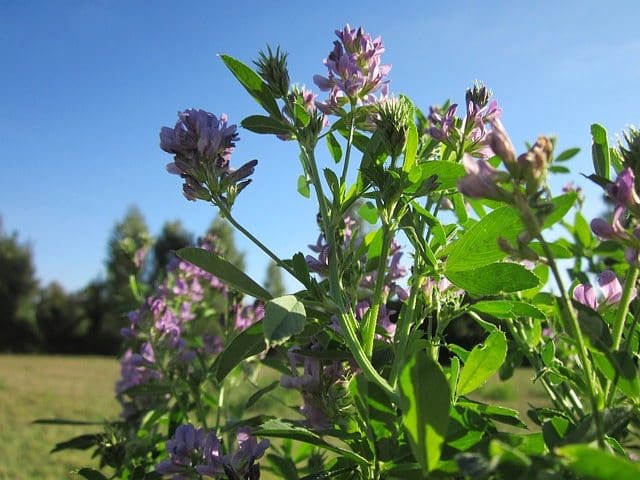One of the advantages of winter is that it forces us indoors, allowing us to spend some quiet-time thinking and planning for the upcoming year. One topic that usually comes to mind during these thinking moments is the question: What can be done to improve land productivity?

Trevor Lennox,
Regional Forage Specialist,
Ministry of Agriculture
One option to consider for improving land productivity is to increase the amount of legumes. Alfalfa is the most important of the legume options. It is the backbone of many livestock operations, but seldom gets the credit deserved for providing abundant, high quality forage.
On a livestock operation, alfalfa will usually give you more bang for your buck than any other forage plant.
Alfalfa is not an expensive crop to plant, but has the potential to fix some of the highest amounts of nitrogen, while providing abundant forage for livestock. Alfalfa is often referred to as the “queen of the forage crops” due to its excellent nutritional qualities and high digestibility.
It is the standard of excellence against which all other forage crops are compared.
[emember_protected for=”2″ custom_msg=’For more on this story, please see the Dec. 22 print edition of The Cross Roads.’]
As the cost of nitrogen fertilizers rises alfalfa will continue to play an important role. The alfalfa plant is a miniature nitrogen factory, tapping the limitless nitrogen supply in the air and converting it into a form readily used by the plant.
Furthermore, alfalfa is acknowledged by plant scientists to produce more protein per acre than any other known crop.
Twenty years ago when I first started working as a professional agrologist, just a few graziers were starting to graze alfalfa. The majority of producers were completely scared to use alfalfa due to its potential to cause bloat in livestock. However over the years, more and more producers have come to recognize the value of alfalfa as a valuable tool on their farm or ranch, and many are using it in pasture mixtures. If you calculate the additional pounds/acre you gain with alfalfa as part of a pasture mixture, a producer could potentially afford to lose an animal or two and still be better off financially.
Numerous bloat prevention techniques are available for grazing pastures that contain a significant amount of alfalfa, however none of them are 100 per cent risk free.
One option is to include Sainfoin, a non-bloating legume, in the grazing mixture at 15 to 20 per cent. Another option is to cut the alfalfa and allow it to wilt for 24 to 48 hours before grazing to provide additional bloat protection (this would mean moving an electric fence every couple of days). Feed and water additives are also available to lower the risk of bloat.
CRC bolus – Rumensin can be added to feed supplements to help prevent bloat. Alfasure is a liquid product added to the water supply that is effective in preventing bloat if the water source can be controlled.
When grazing pasture mixtures containing a significant amount of alfalfa, the following tips can help reduce the risk of bloat:
• Once alfalfa has reached 15 to 20 per cent bloom stage, the risk of bloat drops substantially.
• Cattle should never be turned into an alfalfa pasture until they have been fully fed first, this will prevent over consumption of fresh alfalfa when first turned into the pasture.
• Never move cattle in the morning, 2 to 5 p.m. is a better option. The soluble protein levels will be lower later in the day, which will help reduce the bloat potential.
• Moving cattle during a rain is not as dangerous as moving them two days later when it is hot. Under those conditions, alfalfa is growing rapidly and at a high risk for bloat. The more rapidly the alfalfa is growing, the more bloat prone it will be due to less cell wall materials to slow down the rate of digestion.
• Have an escape pasture –the ability to take the herd off of alfalfa if conditions for grazing are poor.
• Observe what the cattle are eating and make sure they are mixing alfalfa with grass.
• Bloat usually occurs one hour to one and one-half hours after a major grazing bout. Major grazing bouts tend to occur shortly after sunrise and early in the evening.
• Do not stay in a paddock longer than two to three weeks, as alfalfa starts to regrow. The regrowth will have a higher potential for bloat.
• There are also some salt/mineral mixtures that can be helpful in reducing the potential for bloat.Grazing pastures containing alfalfa forces the grazier to pay more attention to the stage of the alfalfa, the environmental conditions, and also to the grazing habits of the livestock. For those who have never grazed pastures containing alfalfa, you can usually find a local neighbour or friend who will mentor you and share their experiences with you. Producers who successfully graze alfalfa/grass mixtures will usually tell you that the benefits far outweigh the risks.
Good luck planning for a successful grazing season in 2018!
For further information, or to share your own experience with grazing alfalfa mixtures, feel free to contact Trevor Lennox, regional forage specialist with the Ministry of Agriculture, at 306-778-8294 or [email protected]

